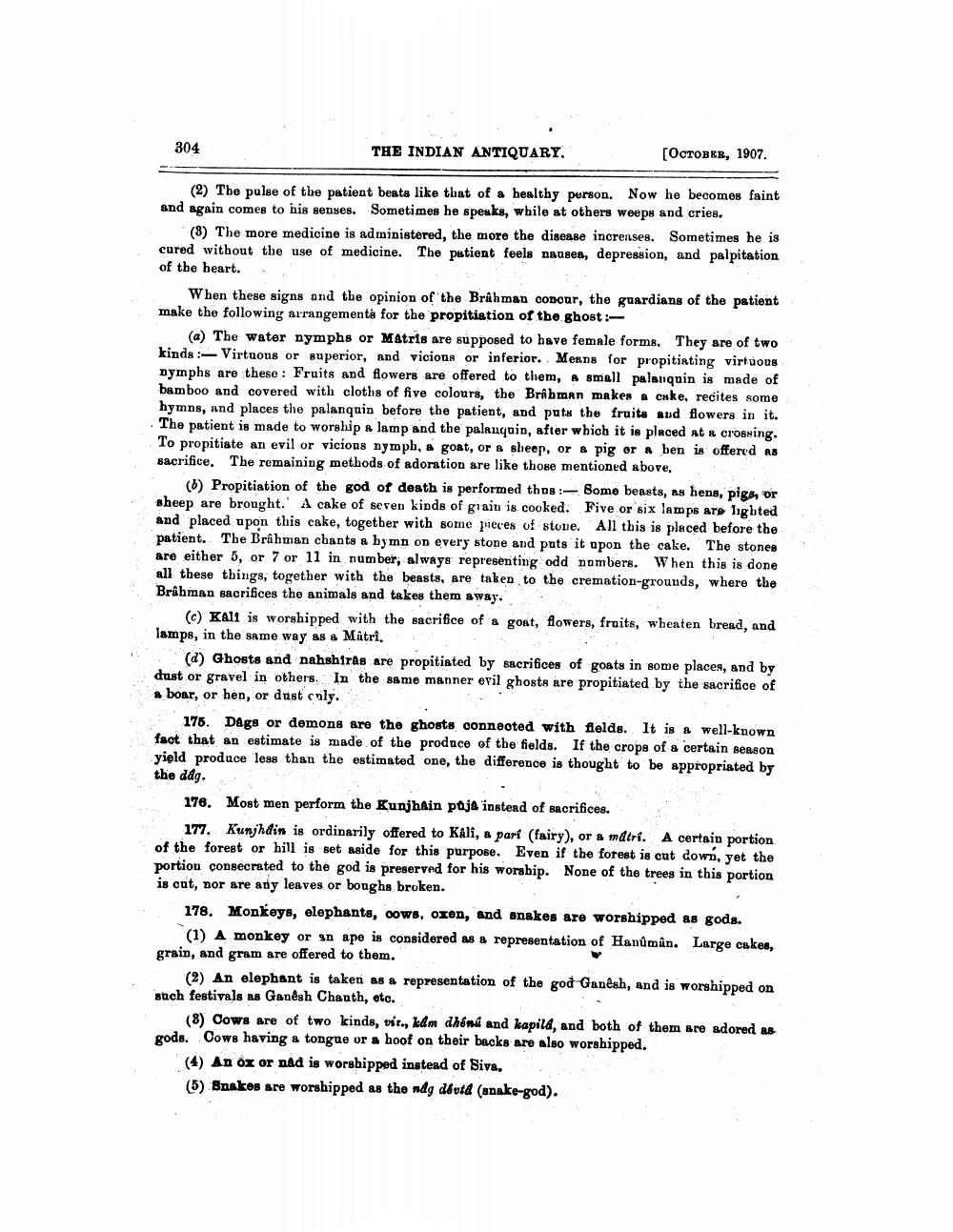________________
304
THE INDIAN ANTIQUARY,
[OCTOBER, 1907.
(2) The pulse of the patient beats like that of a healthy person. Now he becomes faint and again comes to his senses. Sometimes he speaks, while at others weeps and cries.
(3) The more medicine is administered, the more the disease increnses. Sometimes he is cured without the use of medicine. The patient feels nausea, depression, and palpitation of the heart.
When these signs and the opinion of the Brahman concur, the guardians of the patient make the following arrangements for the propitiation of the ghost:
(a) The water nymphs or Matris are supposed to have female forms. They are of two kinds :- Virtuous or superior, and vicious or inferior. Means for propitiating virtuous nymphs are these : Fruits and flowers are offered to them, A small palanquin is made of bamboo and covered with cloths of five colours, the Brahman makes a cake, recites some hymns, and places the palanquin before the patient, and puts the fruits and flowers in it. The patient is made to worship a lamp and the palanquin, after which it is placed at & crossing. To propitiate an evil or vicions nymph, a goat, or a sheep, or a pig or * ben is offered as sacrifice. The remaining methods of adoration are like those mentioned above.
(6) Propitiation of the god of death is performed thos:- Bome beasts, as hens, pigs, or sheep are brought. A cake of seven kinds of grain is cooked. Five or six lamps are lighted and placed upon this cake, together with some preces of stone. All this is placed before the patient. The Brâhman chants a hymn on every stone and puts it upon the cake. The stones are either 5, or 7 or 11 in number, always representing odd numbers. When this is done all these things, together with the beasts, are taken to the cremation-grounds, where the Brahman sacrifices the animals and takes them away.
(©) Kali is worshipped with the sacrifice of a gost, flowers, fruits, wheaten bread, and lamps, in the same way as a Mátri.
(d) Ghosts and nahshiras are propitiated by sacrifices of goats in some places, and by dast or gravel in others. In the same manner evil ghosts are propitiated by the sacrifice of #boar, or hen, or dust coly.
176. Dags or demons are the ghosts connected with fields. It is a well-known fact that an estimate is made of the produce of the fields. If the crops of a certain season yield produce less than the estimated one, the difference is thought to be appropriated by the ddg.
176. Most men perform the Kunjh&in poja instead of sacrifices.
177. Kunjhdin is ordinarily offered to Kali, a part (fairy), or a matrí. A certain portion of the forest or hill is set aside for this purpose. Even if the forest is cut down, yet the portion consecrated to the god is preserved for his worship. None of the trees in this portion is cut, nor are any leaves or boughs broken.
178. Monkeys, elephants, cows, oxen, and snakes are worshipped as gods.
(1) A monkey or sn ape is considered as a representation of Hanuman. Large cakes, grain, and gram are offered to them.
(2) An elephant is taken as a representation of the god Ganesh, and is worshipped on such festivals as Ganesh Chanth, etc.
(8) Cows are of two kinds, vit., kam dhoni and kapild, and both of them are adored as gods. Cows having a tongue or a hoof on their backs are also worshipped.
(4) An óx or nad is worshipped instead of Siva 6) Snakos are worshipped as the ndg dôvt& (snake-god).




